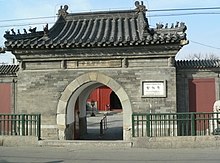Zhihua Temple
| Zhihua Temple | |
|---|---|
Buddhist Texts Library of the temple | |
| Religion | |
| Affiliation | Buddhism |
| Location | |
| Location | Beijing |
| Country | China |
| Geographic coordinates | 39°54′58″N 116°25′33″E / 39.9162°N 116.4259°E |
The Zhihua Temple (
The temple, surrounding buildings, and grounds comprise approximately 2 hectares (4.9 acres). It is one of the most important original building complexes that has remained intact since the Ming dynasty period in the Old City area of Beijing.[3] It is also striking for its extensive use of black roof tiles. The Beijing Cultural Exchange Museum, established in November 1992, is located in the temple compound; its principal aim is "as a centre for developing cultural exchange and for developing the study of cultural relics and museums."[4]
At the temple, a group of musicians regularly performs centuries-old ritual music which has been handed down over 27 generations. The six-member group was led by the octogenarian Buddhist monk Zhang Benxing (张本兴, 1923-2009),[1] the only surviving member of the 26th generation of musicians, and the last person to have learned the music in the traditional manner.[citation needed] In addition to singing voices, the instruments used include guanzi (oboe), dizi (bamboo flute), sheng (mouth organ), yunluo (a set of ten small tuned gongs mounted vertically in a frame), and percussion including drums and cymbals.
The Zhihua Temple became a nationally preserved cultural and historic relic in 1961. In 2005 the Chinese government undertook a renovation of the temple (which is now complete) in preparation for the numerous international visitors expected at the time of the 2008 Summer Olympics.
Layout
The structures of the temple mostly date to the Ming dynasty.
Shanmen

The shanmen (Chinese: 山門; Pinyin: Shānmén) of Zhihua Temple dates to the Ming dynasty. It consists of a single archways 7.10 meters wide and 5 meters long, with a single-eaved xieshan-style roof. A white marble plaque is embedded on the top of the gate, which is inscribed with the words "敕賜智化寺" in traditional Chinese characters, meaning "Gifted by the Imperial Court to Zhihua Temple". The left and right sides of the shanmen are also inscribed with Chinese characters; the left inscription reads "正九年正月初九日奉旨敕建", which means "Built under Imperial order on the 9th day of the 1st lunar month of the 9th year of the reign of the Zhengde Emperor", while right inscription reads "萬曆五年三月三日司禮監管監事兼掌內府供用庫印提督禮儀房太監鄭真等重修", which means "Rebuilt by the eunuch Zheng Zhen, the Master of Ceremonies who oversees the inner palace and the ceremonial room, as well as others in the 3rd day of the 3rd month of 5th year of the reign of the Wanli Emperor". Two Chinese guardian lions guard both sides of this gate.
Zhihua Gate

The Zhihua Gate (
Bell Tower
The
Drum Tower
The Drum Tower (Chinese: 鼓樓; Pinyin: Gǔlóu) is located on the west side outside Zhihua Gate and also consists of two floors. It houses a Ming dynasty drum, which has a height of 1.45 meters and a diameter of 1.37 meters. The surface of the drum is inscribed with a lacquer pattern composing of 12 golden dragons prancing.
Zhihua Hall

The Zhihua Hall (
In modern times, the temple enshrines another set of Ming dynasty statues of the Buddhas
Tathagata Hall and Thousand Buddha Pavilion
The Tathagata Hall (
-
Interior of the building
-
Close up image of Saka
-
Close up image of Brahma
Buddhist Texts Library
The
.-
转轮藏/Rotating wooden sutra cabinet
-
Close up image of the carving
-
Vairocana Buddha sitting on the top of the cabinet
References
- ^ chinaculture.org Archived September 4, 2006, at the Wayback Machine
- ^ china.org
- ^ planetware.com
- ^ english.bjta.gov.cn Archived April 4, 2005, at the Wayback Machine






